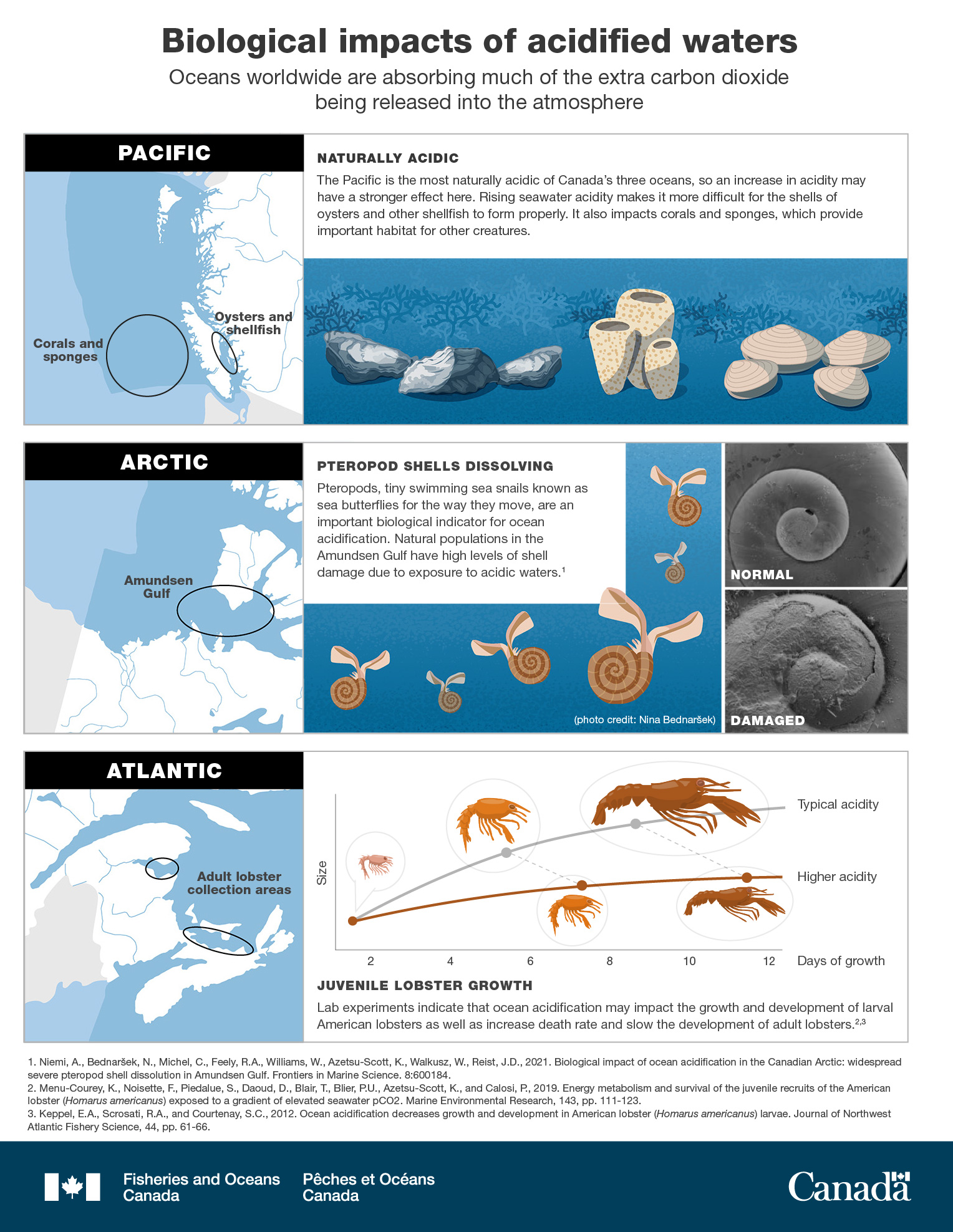Biological impacts of acidified waters

Description: Biological impacts of acidified waters
This figure shows the observed impacts of ocean acidification on marine life in Canada's three oceans in three stacked panels. The top panel shows a map of the Pacific coast with a circle off the west coast of Vancouver Island showing areas of corals and sponges as well as a smaller circle in between Vancouver Island and the mainland of British Columbia showing oyster and shellfish areas impacted by acidification.
The middle panel shows a map of the Arctic ocean, zoomed in to Admundson Gulf with a circle showing areas where pteropods are impacted by acidification. Beside the Arctic map are illustrations of pteropods with accompanying text. At right of the panel are two photos of a pteropod shell, one is a smooth, normal texture and the other is a rough, damaged texture.
The bottom panel shows a map of the Atlantic coast with a circle over Chaleur Bay in the western Gulf of St. Lawrence and another circle over the Northumberland Straight between Nova Scotia and Prince Edward Island showing areas where adult lobsters were collected for studies of acidification impacts. A graph of size over days of growth shows that the growth of juvenile lobsters is lower in acidic conditions than in typical conditions.
Text
Biological impacts of acidified waters
Oceans worldwide are absorbing much of the extra carbon dioxide being released into the atmosphere.
Pacific
Naturally acidic
The Pacific is the most naturally acidic of Canada's three oceans, so an increase in acidity may have a stronger effect here. Rising seawater acidity makes it more difficult for the shells of oysters and other shellfish to form properly. It also impacts corals and sponges, which provide important habitat for other creatures.
Arctic
Amundsen Gulf
Pteropod shells dissolving
Pteropods, tiny swimming sea snails known as sea butterflies for the way they move, are an important biological indicator for ocean acidification. Natural populations in the Amundsen Gulf have high levels of shell damage due to exposure to acidic waters.
Atlantic
Adult lobster collection areas
Juvenile lobster growth
Lab experiments indicate that ocean acidification may impact the growth and development of larval American lobsters as well as increase death rate and slow the development of adult lobsters
Size, Days of growth, Typical acidity, Higher acidity
References
- Niemi, A., Bednaršek, N., Michel, C., Feely, R.A., Williams, W., Azetsu-Scott, K., Walkusz, W., Reist, J.D., 2021. Biological impact of ocean acidification in the Canadian Arctic: widespread severe pteropod shell dissolution in Amundsen Gulf. Frontiers in Marine Science. 8:600184.
- Menu-Courey, K., Noisette, F., Piedalue, S., Daoud, D., Blair, T., Blier, P.U., Azetsu-Scott, K., and Calosi, P., 2019. Energy metabolism and survival of the juvenile recruits of the American lobster (Homarus americanus) exposed to a gradient of elevated seawater pCO2. Marine Environmental Research, 143, pp. 111-123.
- Keppel, E.A., Scrosati, R.A., and Courtenay, S.C., 2012. Ocean acidification decreases growth and development in American lobster (Homarus americanus) larvae. Journal of Northwest Atlantic Fishery Science, 44, pp. 61-66.
- Date modified: